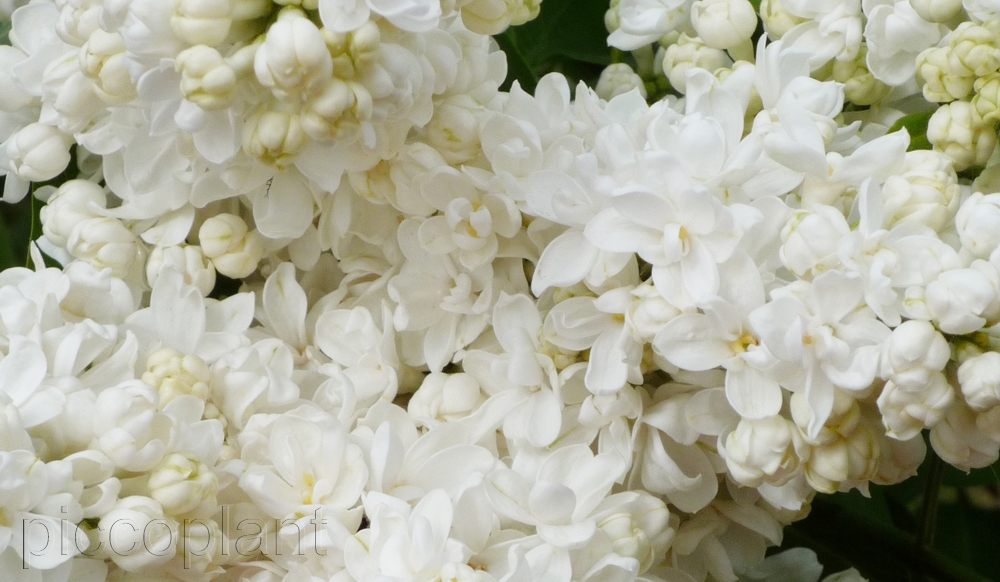The PICCOPLANT Syringa assortment includes more than 400 varieties. It covers the full range of colours, with both single- and double-flowered varieties.

Syringa Classics

White Rarities

Blue Rarities

Lilac Rarities

Rose Rarities

Magenta Rarities

Purple Rarities

Syringa hyacinthiflora

Special Syringa
-

Syringa Classics
The classics of our assortment beguile our gardens for many years with their fragrance. Syringa vulgaris hybrids are summergreen, upright shrubs with an average height of about 3-4 meters. Some varieties can be up to 6 meters tall. They are all based on varieties of Syringa vulgaris, the ordinary lilac, which is native to South-East Europe. The large, upright panicles of Syringa vulgaris hybrids appear in the middle of may to the beginning of June and give off the typical lilac scent. -
White Rarities
"When the white lilac blooms again..." White lilac - a symbol of purity, innocence and first love. No matter, whether simple or filled: A must-have in every garden! Syringa vulgaris hybrids are summergreen, upright shrubs with an average height of about 3-4 meters. Some varieties can be up to 6 meters tall. They are all based on varieties of Syringa vulgaris, the ordinary lilac, which is native to South-East Europe. The large, upright panicles of Syringa vulgaris hybrids appear in the middle of may to the beginning of June and give off the typical lilac scent. -

Blue Rarities
Blue lilacs are a central symbol of romanticism. The color blue is perceived as "royal". Syringa vulgaris hybrids are summergreen, upright shrubs with an average height of about 3-4 meters. Some varieties can be up to 6 meters tall. They are all based on varieties of Syringa vulgaris, the ordinary lilac, which is native to South-East Europe. The large, upright panicles of Syringa vulgaris hybrids appear in the middle of may to the beginning of June and give off the typical lilac scent. -
Lilac Rarities
Lilacs got their name because of this colour. Syringa vulgaris hybrids are summergreen, upright shrubs with an average height of about 3-4 meters. Some varieties can be up to 6 meters tall. They are all based on varieties of Syringa vulgaris, the ordinary lilac, which is native to South-East Europe. The large, upright panicles of Syringa vulgaris hybrids appear in the middle of may to the beginning of June and give off the typical lilac scent. -
Rose Rarities
In a range of delicate porcelain pink to bright rose lilacs are offering everything, that stands for romance and love! Syringa vulgaris hybrids are summergreen, upright shrubs with an average height of about 3-4 meters. Some varieties can be up to 6 meters tall. They are all based on varieties of Syringa vulgaris, the ordinary lilac, which is native to South-East Europe. The large, upright panicles of Syringa vulgaris hybrids appear in the middle of may to the beginning of June and give off the typical lilac scent. -
Magenta Rarities
Lilacs in red are a must-have in any private collection! Many shades of magenta, fuchsia and purple are possible. Syringa vulgaris hybrids are summergreen, upright shrubs with an average height of about 3-4 meters. Some varieties can be up to 6 meters tall. They are all based on varieties of Syringa vulgaris, the ordinary lilac, which is native to South-East Europe. The large, upright panicles of Syringa vulgaris hybrids appear in the middle of may to the beginning of June and give off the typical lilac scent. -
Purple Rarities
Purple lilacs belong - besides magenta - to the darkest lilac colors. Syringa vulgaris hybrids are summergreen, upright shrubs with an average height of about 3-4 meters. Some varieties can be up to 6 meters tall. They are all based on varieties of Syringa vulgaris, the ordinary lilac, which is native to South-East Europe. The large, upright panicles of Syringa vulgaris hybrids appear in the middle of may to the beginning of June and give off the typical lilac scent. -
Syringa hyacinthiflora
Syringa hyacinthiflora hybrids emerged for the first time in 1876 by a crossing of a filled S. vulgaris with S. oblata by Victor Lemoine. The Hybrid was named after the hyacinth-like shape of its flowers. Initially, unfilled, varieties with double flowers came later as well. S. hyacinthiflora are blooming a little earlier than S. vulgaris and are a well suited means, to expand the lilac season in the gardens. They possess a bushier habitus than many vulgaris and bloom not only earlier, but also rich. -
Special Syringa
Syringa x prestoniae and Syringa josiflexa were bred by Isabella Preston in the middle of the 20th century in Canada. This caused their nickname: "Canadian lilacs". Both stand out with an extreme winter hardness. Also, they differ very much from Syringa vulgaris plants through their leaf shape and habitus. The bloom begins approximately 2 to 3 weeks later than S.vulgaris and has its own exotic scent. Therefore, prestoniae varieties are well suited for prolonging the lilac season in a garden. They grow to a height of about 2.5 meters and have fragrant, unfilled and elogated single flowers, that grow in loose panicles. Especially appealing are the unopened flowers. these varieties are very well suited for bucket growth. Syringa x chinensis originated from a natural hybrid of S. vulgaris and S. laciniata and was first discovered in 1777, in the Botanical garden of Rouen. Syringa x chinensis is one of the most beautiful lilac varieties and well suited for garden usage. The "royal lilac" grows only a few stolons and forms 4 m high and equally wide, round bushes. Royal lilacs are very undemanding and can even be used as a windbreak hedge. Dryness in summer will be tolerated, waterlogging won't. The strongly scented flowers appear a little later than S. vulgaris, which is advantagous in frost prone locations. The small, simple single flowers form loose, overhanging, 15 - 30 cm long panicles in great abundance. Blooming royal lilacs belong to the most beautiful, what a garden has to offer in may.








